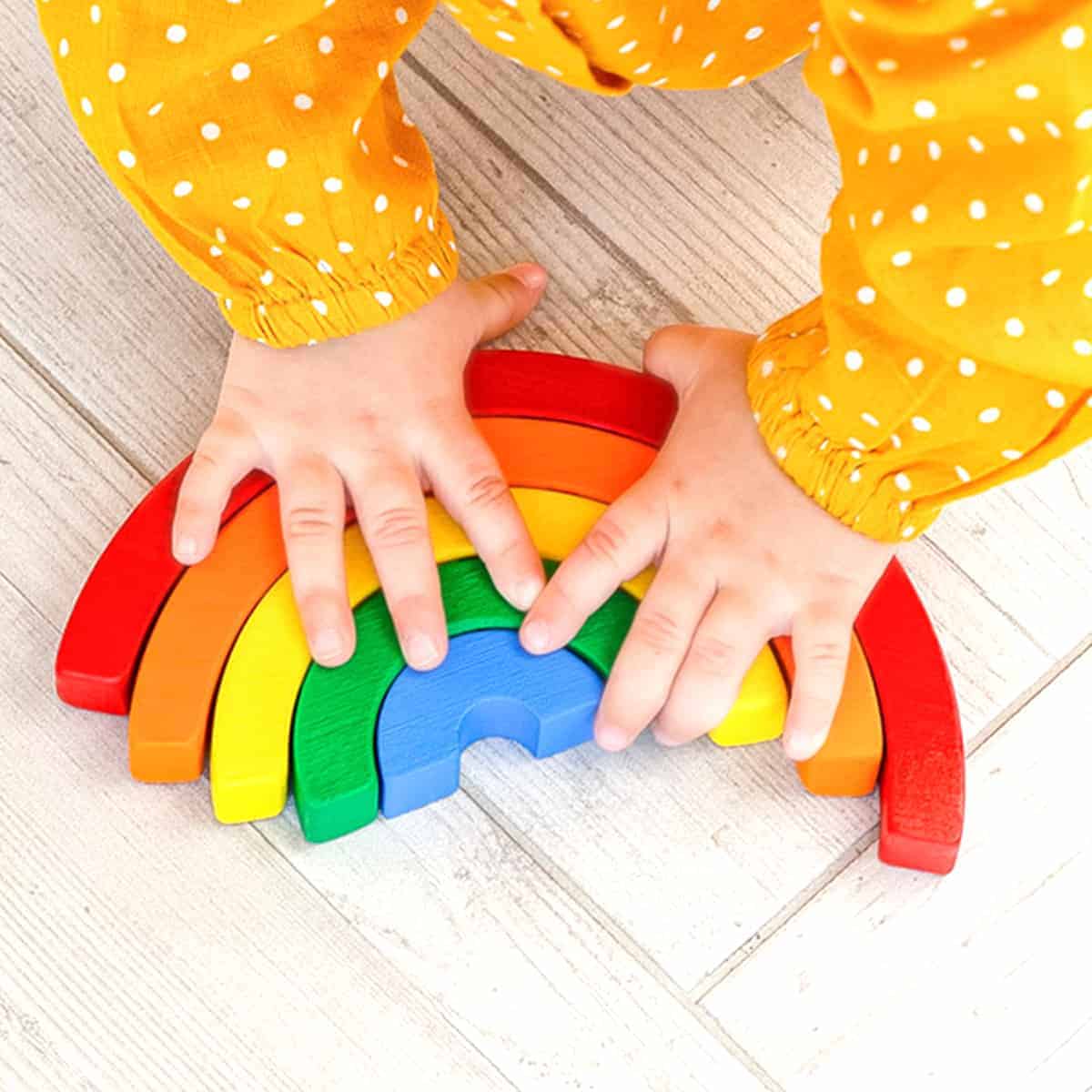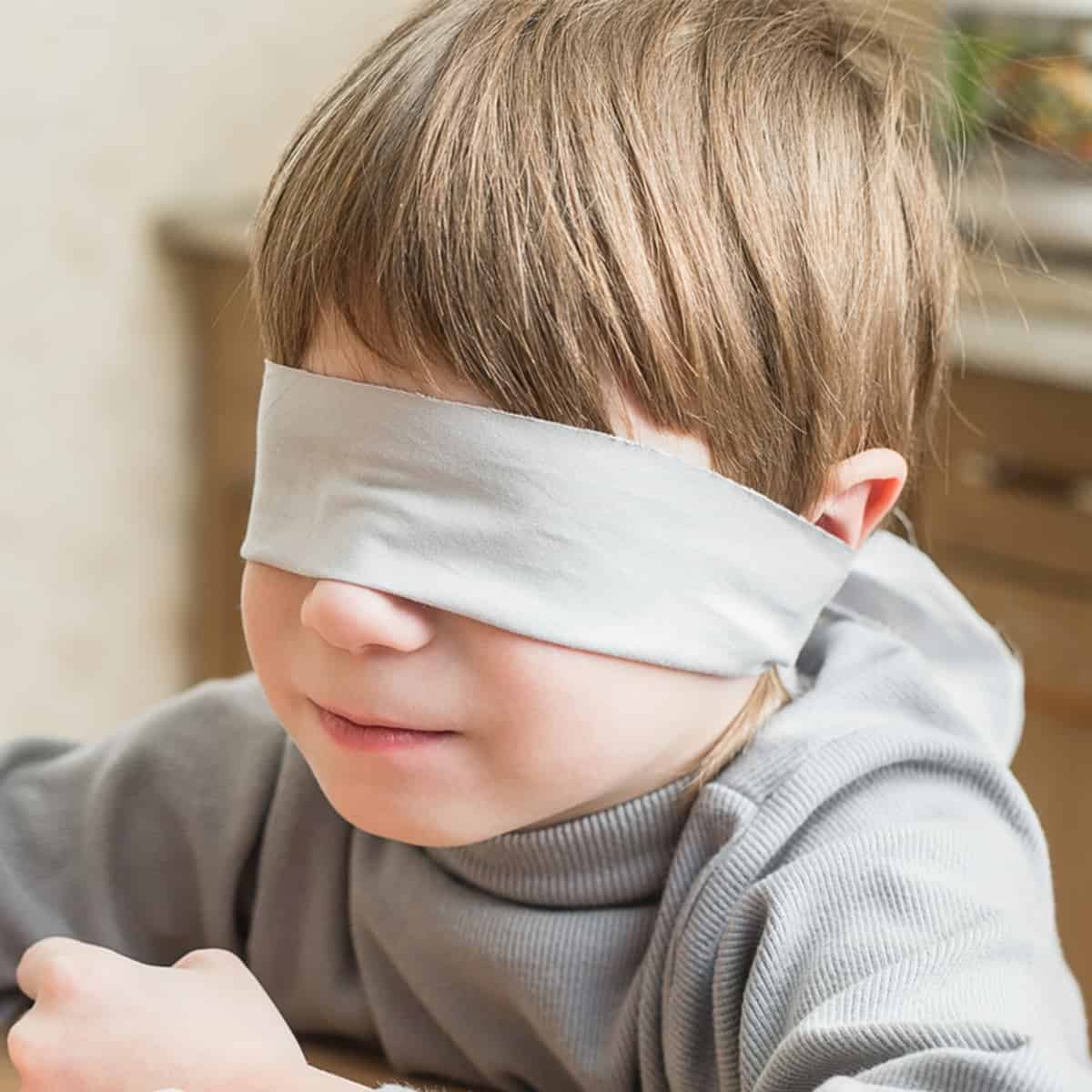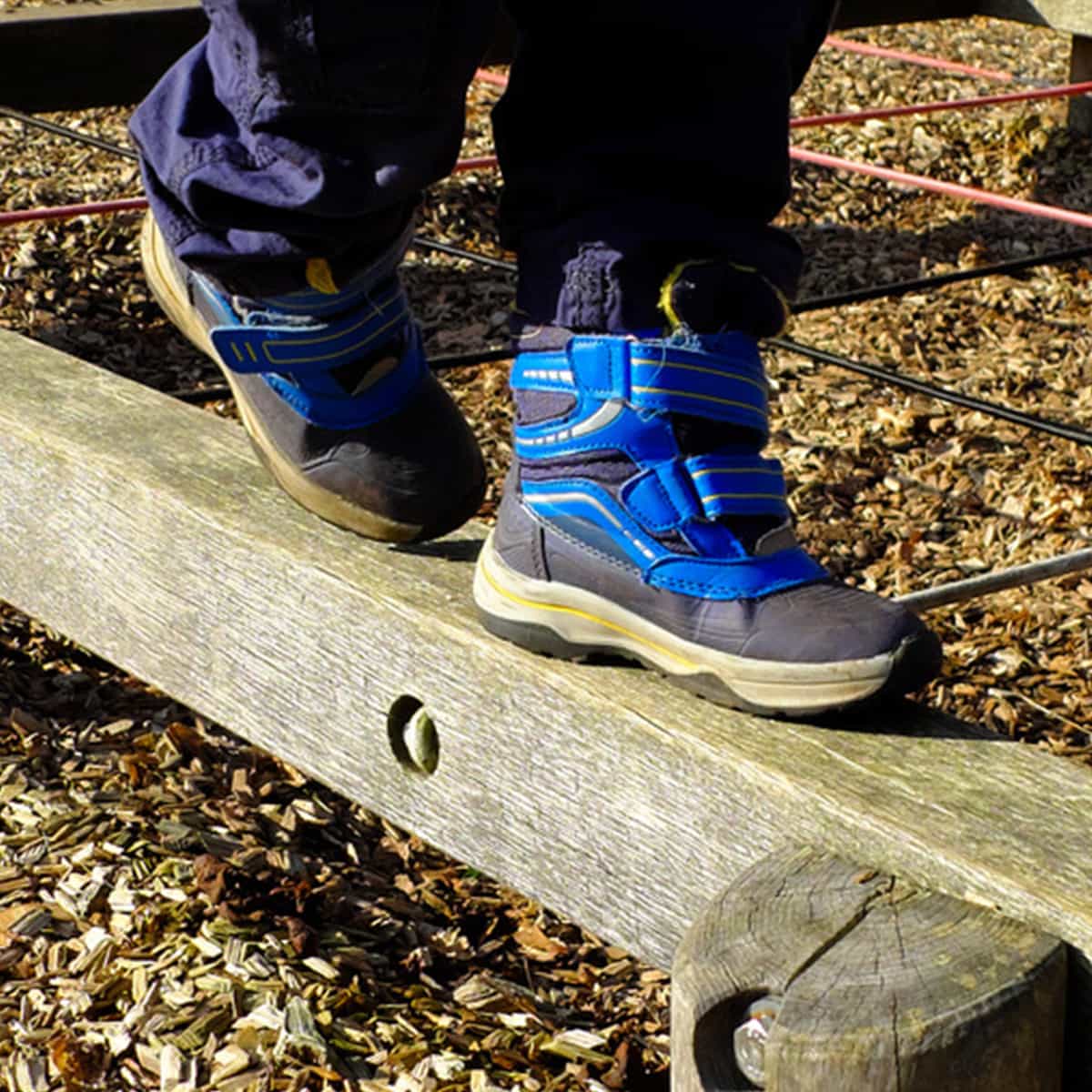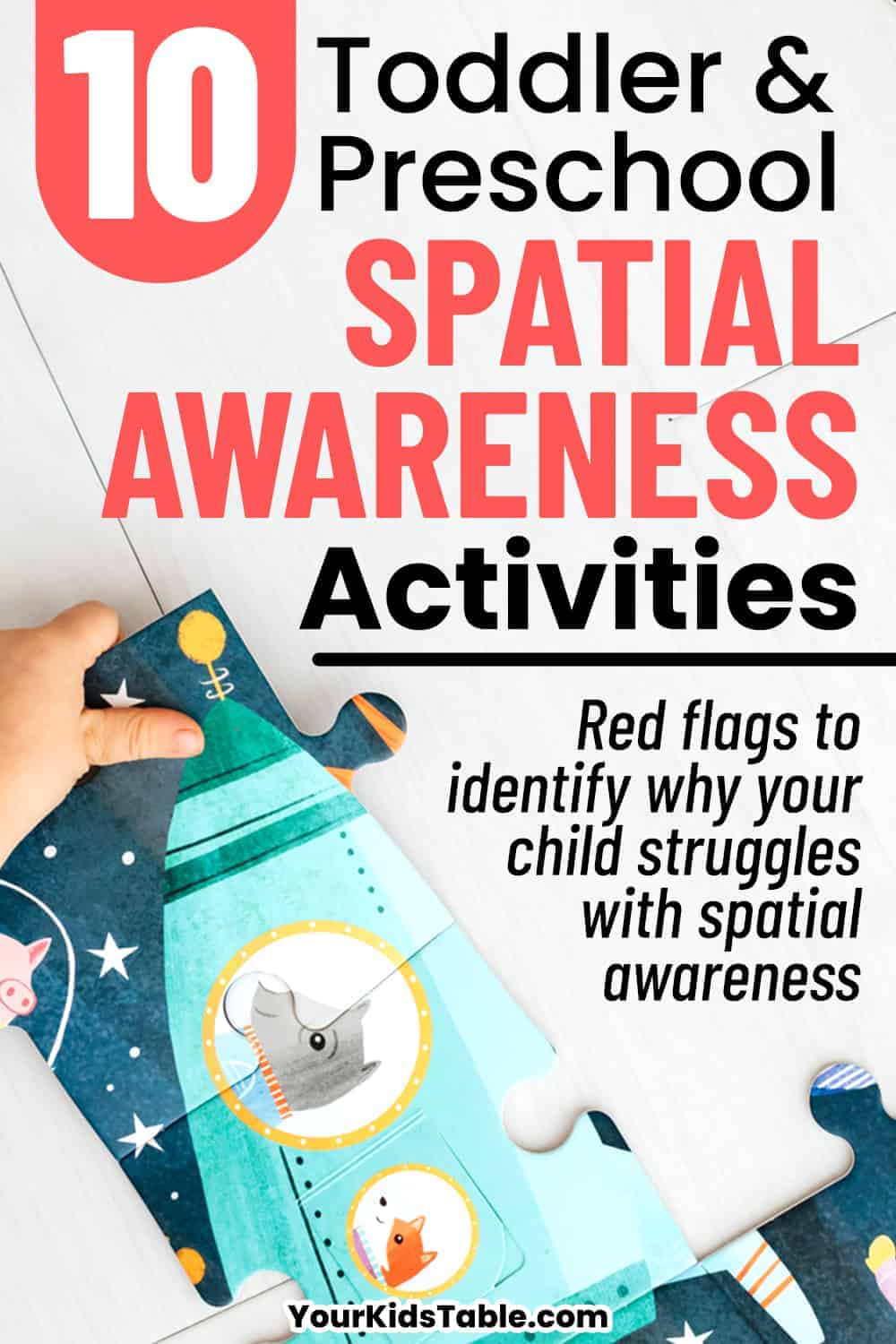Learn 10 easy spatial awareness activities that improve this important skill that can affect handwriting, hand eye coordination, clumsiness, and more…
Affiliate links used below. See our full disclosure.
From infancy, babies start learning and building skills that will grow through childhood and take them into adolescence and then adulthood.
Many of these developmental milestones, from first steps, first bike rides without training wheels, and even driving a car for the first time involve complex physical and perceptual skills that begin to take shape shortly after birth.
As an occupational therapist who specializes in pediatrics, I know that the occupation of childhood is play, and the vast majority of life skills come about through play and the exploration of the world around us.
Popular childhood games such as “hide and seek,” “tag,” “duck, duck, goose,” and even free play outdoors all challenge a child’s body and mind to develop a variety of skills.
One of those skills that’s often overlooked, but is learned through running, climbing, chasing, and physically interacting with other kids and the environment around them is spatial awareness.
Beyond the obvious physical component of completing these activities, this deeper skill of spatial awareness requires perception of where your body is in space, what objects are in your environment and how much space they take up, and how to safely interact between the two.
What is Spatial Awareness?
Spatial awareness is your child’s perception of their body in relation to and interaction with their physical environment and it’s a critical skill for play, development, and learning.
It may seem simple enough, but spatial awareness (sometimes called body awareness) is a complex and higher-level physical and cognitive skill set that is deeply tied to the sensory system.
Because our senses themselves are so interconnected, it’s important to understand how they work together to help a child know how to interact with their environment appropriately and safely.
Touch, vision, vestibular, and proprioceptive systems all have important roles in spatial awareness.
Touching and exploring the world with our hands and body, for example, is a critical part of understanding the physical world around us and how we can create, move, and interact with it all.
Scanning our environment with our eyes and bringing input into the brain to be perceived and processed helps us understand where we are and provide context to the world.
Processing our head and body position with our inner ear, which the vestibular system is responsible for, allows us to internally feel and process speed, direction changes, and orientation to our own self and the world.
And the sensors in our skin, muscles, and joints through the proprioceptive sense send important messages to our brain to allow us to use coordinated movement to move through our environment.
This is all just the tip of the iceberg to the complex skill known as spatial awareness, and you can see why when one area of sensory is impacted through sensory processing difficulty, everything else might be impacted, too.
What Skills Do Spatial Awareness Impact:
Just like the sensory system is interconnected and greatly impacts how we develop spatial awareness, many other areas can be affected when spatial awareness is underdeveloped in children.
Social skills
Knowing how to respect the personal space of others, how to move through crowds, and both giving and following directions fall under important social skills that kids develop over time.
Spatial awareness is also involved in reading social cues appropriately, including body language and physical interactions like high fives, hugs, and holding hands.
Motor skills
Navigating your environment, staying safe from dangerous obstacles, knowing how to orient your body for dressing, holding a pencil, managing fasteners, and perceiving how the world and people around you are moving all involve an awareness of your body and the space around it.
Academics
Understanding letter formation, spacing, and sentence structure, reading, following rules of grammar and mathematical concepts, like arranging equations or understanding physical sciences like geometry or size are less obvious, but still tied to spatial awareness skills.
Proprioception
Our sense of body awareness, and the sensory receptors in our joints, muscles, and skin tell us what our body is doing and where it is. An example of proprioception impacting spatial awareness are bumping into objects or other people in your environment.
Play skills
Building towers, driving cars on a track, coloring within lines, throwing and catching a ball- almost ALL play involves spatial awareness to some degree.
Safety awareness
A child who cannot perceive either their own space or the space around them is more likely to engage in risky or dangerous behaviors and actions. These can be unintentional, like falling off a set of steps or bed, or intentional, like jumping off a play structure that is too high.
As you can see, these are huge areas of development that help kids become independent and functional in their play, learning, and home environments.
But sometimes these deficits aren’t very obvious. You may be wondering what challenges a child with poor spatial awareness has.
Signs of Spatial Awareness Difficulty
A child with spatial awareness difficulties may be described as “wild,” “uncoordinated,” or even “reckless.”.
The following list are some red flags to look for if you think your child might be struggling with spatial awareness:
- Trouble respecting personal space, standing too close, leaning on others, or keeping hands to self.
- Difficulty with reading, writing, or math in the school aged years.
- Coordination problems, such as appearing clumsy, being unable to throw or catch a ball, misses if trying to kick a ball.
- Trouble using 2 hands together for zippers, buttons, play activities.
- Seems oblivious to environmental dangers such as curbs, corners, and objects in their path.
- Looking down at their feet while walking because they stumble otherwise.
- Fearful of play equipment that other children seem to be comfortable playing on.
- Misses the mouth when self-feeding.
- Problems understanding directions like left vs. right and up vs. down in school years.
- Trouble following instructions with directions such as “your crayons are under the table” or “the soap is next to the towel.”
- Writing vertically instead of horizontally or starting sentences in the middle of the page.
- Poor hand eye coordination
- Poor legibility and sizing/spacing/orientation to writing.
Cause of Spatial Awareness Difficulties
Multiple areas of the brain play a role in spatial awareness, and typically, this skill starts developing in infancy.
There are several clinically based reasons a child may have trouble developing spatial awareness, such as: Sensory Processing Disorder, Autism Spectrum Disorder,
Dyspraxia, or Attention Deficit Hyperactivity Disorder.
However, many kids struggle with spatial awareness without a clear diagnosis. There are many factors that shape these skills including sensory and motor development, vision skills, and cognition and perception abilities.
How to Improve Spatial Awareness in Kids
Fortunately, you can improve spatial awareness skills with practice, and there are so many ways to do this.
In young children, identifying body parts through silly songs like “Head, shoulder, knees, and toes” are a great way to build these skills. Even simple nursery rhymes with hand gestures can help kids learn where they are in space.
For older kids, regularly discussing locations and distances helps reinforce those concepts. Simple map following or reviewing directions as you walk around the block can help.
Play-based activities are my favorite way to address these skills, because kids don’t even know they’re working on them. Construction toys like Legos, magnet tiles, blocks, and Lincoln Logs are all great for this.
Drawing, crafts, and even some video games, like Minecraft, where you must manipulate objects and build, or puzzle games like Tetris and Rush Hour, help develop spatial awareness.
The key is to practice, practice, practice. The more opportunities your child has to challenge their own sensory and motor systems, the more opportunity they have to build these skills.
10 Spatial Awareness Activities
If you’ve identified that your child may be struggling with spatial awareness and want to practice, try some of the following activities:
1.Puzzles
Depending on your child’s age and abilities, different types of puzzles help practice spatial awareness skills. Shape sorters, jigsaw puzzles, peg puzzles, and 3D puzzles are all options.
Shape and nesting puzzles are a great choice. There are so many things kids can make, it offers great practice.

For older kids, another great puzzle activity is something like Mental Blox. It’s different from standard puzzles and requires kids to use three dimensional shapes to recreate the images.
2. Build Obstacle Courses
This is a tried and true occupational therapy activity that kids love.
The ability to maneuver through an obstacle course requires spatial awareness. Put together sequential steps for your child to complete with objects from around the house. Include crawling, climbing, and following a path.
Or, head outside to a playground and have your child complete climbing, running, jumping, or crawling.
Get inspired with this fun obstacle course that also targets handwriting skills.
3. Follow the Leader
Play a game of follow the leader and have your child mimic big and small body movements. That could include jumping, lunging, or walking on tip toes and putting hands on hips. You can also practice giving appropriate space between participants.
Games like “Simon Says” and “Mother May I?” are great for developing spatial awareness.
4. Hide a Toy
This is such an easy game to play, and you can use just about any toy.
Hide an object somewhere within the room and use directional instructions to tell your child where it is and have them find it.

For example, “The bear is under a blanket on the second shelf.” For older kids, you can have them close their eyes as you call out directions like “take 1 step to your left and 3 steps forward.”
5. Building and Block Play
Construction of towers and block play is a foundational skill that is important in early childhood.
Learning the cause and effect of balancing items, crashing them down, and how to construct them is a great way to practice spatial awareness. Here are a few of my favorite blocks for different ages:
Large interlocking blocks, wooden blocks, and these classic cardboard building blocks.
As children set up, crash down, and rearrange blocks, they become more aware of space and positioning of objects.
Try giving verbal instructions like “put the green block on top” or even mirroring designs for your child to copy.
6. The Floor is Lava
This childhood favorite is an awesome way to work on spatial awareness skills. Similar to an obstacle course, create pathways for your child to follow that avoid certain areas so they have to practice maneuvering around large and small items.
7. Secret Handshakes or Songs with Motions
There is a reason why nursery rhymes often have songs with movement. Kids love them, and they are great for learning spatial awareness.
“Ring around the Rosy,” “Itsy Bitsy Spider,” “Pat-a-cake” and “If You’re Happy and You Know It” are a fun way to start working on these skills from infancy into the school years.
8. Sports and physical activity
Basketball, baseball, soccer, or any game involving a ball helps develop spatial awareness.
Learning how much force to dribble a basketball or to kick the soccer ball so it reaches the net, and how to swing a baseball bat just in time to hit the ball thrown by the pitcher are athletic skills that require spatial awareness.
Gymnastics and dance also help build a strong sense of body awareness and a better understanding of space and proximity to others and to the objects around you.

Organized sports are definitely not the only way. ALL play and movement, whether it’s skiing, rock climbing, biking, swimming, or just running around the yard help improve spatial awareness.
9. Coloring, painting, or simple crafts
Simple crafts involve a combination of visual, perceptual and motor skills to follow directions, color, cut, and paste items together. Having your child follow physical examples of crafts are a great way to encourage these skills and build spatial awareness.
10. Yoga
Yoga is not only a great way to build spatial awareness for kids, but is also a sensory powerhouse for children who have sensory processing difficulties.
Between the movement, direction following, and focus on breathing and mindfulness, it is a perfect way to work on a range of developmental skills in childhood.
Check out Cosmic Kids Yoga or these yoga cards to try with your kids.
There you have it. These 10 activities will help you encourage your toddler or child to build valuable spatial awareness skills.
If you’ve got a child at home who struggles with spatial awareness, which activities will you try to help them out? Let us know below…
Learn More About Supporting Your Child’s Development
Sensory toys for Toddlers, Autism, and SPD
10 Winter Occupational Therapy Activities
Laura Mau is a licensed occupational therapist and member of the Your Kid’s Table team. She has over 8 years of clinical experience in helping families navigate complex feeding and eating, sensory processing, and reaching developmental milestones with their children. She currently practices in Colorado and has 2 young kids of her own.
Alisha Grogan is a licensed occupational therapist and founder of Your Kid’s Table. She has over 18 years experience with expertise in sensory processing and feeding development in babies, toddlers, and children. Alisha also has 3 boys of her own at home. Learn more about her here.
